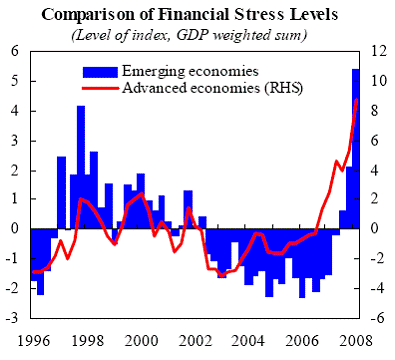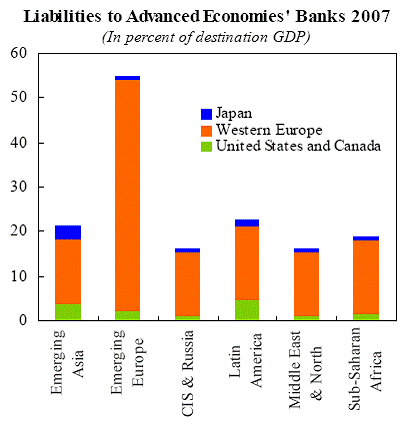As the G-20 leaders meet in London, one graph should remind the representatives of these disparate countries of their shared interest in restoring the health of the financial systems of the developed countries.

Figure from Box 2 IMF.
What this graph shows is financial stress in the advanced economies leads to financial stress in the emerging markets.
The indices depicted were developed for individual countries and will be detailed in a chapter in the forthcoming* IMF World Economic Outlook (by Ravi Balakrishnan, Stephan Danninger, Selim Elekdag and Irina Tytell), to be released later in April. The advanced country financial stress indices (FSI) are a composite of banking sector, interbank spreads, term spreads (described in the October 2008 WEO, Chapter 4). Specifically:
- Banking sector: rolling 12-month covariance of the year-over-year percent change of a country’s banking sector equity index and its overall stock market index, divided by the rolling 12-month variance of the year-over-year percent change of the overall stock market index.
- TED spread: three-month LIBOR or commercial paper rate minus the government short term rate.
- Inverted term spread: government short term rate minus government long-term rate.
The emerging market FSI is constructed as a weighted average of the exchange market pressure index, sovereign spreads, the banking sector beta, stock returns, and time-varying stock return volatility.
The authors note that the pass through of financial stress from advanced countries to emerging markets is almost one-for-one. That being said:
there is significant cross-country variation. An empirical analysis of stress comovement shows that stronger financial (i.e., banking, portfolio, and FDI) linkages are associated with a higher stress pass-through from advanced to emerging economies. During the most recent crisis, bank lending linkages have been the main driver of stress transmission.
This characterization is obtained via a two-step procedure, as in Forbes and Chinn (2004). In the first step, the coefficient relating emerging market stress to advanced is obtained. These coefficients are then treated as data, in a regression on determinants such as FDI and banking linkages.
Another way of seeing the importance of, for instance, bank linkages is by inspecting the emerging market liabilities to advanced country banks:

Figure from Box 2 IMF.
In my view, large liabilities are important to the extent that bank deleveraging implies a long drawn out curtailment of credit to emerging markets. The IMF analysis observes:
Evidence from past episodes of systemic banking stress in advanced economies (Latin American debt crisis of the early 1980s and the Japanese banking crisis of the 1990s) implies that the decline in capital flows may be sizeable and drawn out. Given their large exposure, emerging European economies might be heavily affected, although EU membership offers some protection.
The complete analysis will come out in the next WEO.
* Full Disclosure: I was a consultant on this forthcoming chapter.
Technorati Tags: financial stress index, yield curve,
term spread, TED spread, and exchange market pressure index.
Great stuff Menzie.
If I am not mistaken, emerging economy growth is roughly correlated with growth of advanced rich nations but tends to be much more volatile. That means even sharper contractions.
People in rich nations have only a faint notion of how people in emerging and poor economies can suffer during energy price shocks and then global recessions like this one. Would increased awareness of the interdependence lead to better economic policy outcomes in advanced, rich nations like the USA and Canada? I dunno.
The first chart suggests that developing economy credit conditions worsen far more, in general, than those in developed countries, and remain problematic for far longer. So far, the extent and duration of impairment are roughly similar between developed and developing countries. (Brazil was doing so well…) That suggests lots more pain for emergings, so lots more paid for European banks. They will need to, yes, raise lots more capital and sell off weak assets. Still plenty to do.
This analysis reminds me of Michael Pettis’ book, The Volatility Machine. The world certainly hasn’t decoupled yet. If anything, we are all the more correlated.
Barack Obama and Hu Jintao met today in London. Until China allows its currency to float free, it should stop complaining about dollar losses and focus on the wisdom of buying dollars to keep their currency stable against country with whom it has a huge and growing trade deficit. until some sort of bilateral understanding between china and the u.s. is reached, no stable global recovery is possible.
“What this graph shows is financial stress in the advanced economies leads to financial stress in the emerging markets.”
While I don’t doubt this conclusion, I don’t see it in the first graph; looks pretty concurrent vice some “lead” by the advanced economies.
More importantly to me, I don’t see the slightest hint of an inflection point in the skyrocketing financial stress index. While the metric clearly isn’t fine tuned to daily, weekly, or even monthly measures, it sure looks like things are getting worse more quickly.
This is not good!
Our first experience with this insane stimulus act of expanding the money supply was the work of Richard Nixon and gave us the Great Inflation of the 1970s. I know that many of you did not live through that era so you do not understand just how devastating the US inflation was to other nations of the world.
The nations of the world put their trust in the US in the Bretton woods agreement. That trust was violated within 20 years and the US after sucking the life out of the world through monetary manipulation broke trust and totally left any currency standard – leaving only a “tradition” standard.
In the 1970s hyper-inflation was the norm for those economies that had linked their currencies to the dollar. Argentina, Brazil, and other South and Central American countries experienced turmoil that cost lives and destroyed property. Workers in Argentina refused to be paid in currency because the hype-inflation was so great that the payment would have been worthless within 24 hours.
Fast forward to today. We are beginning the same process as the 1970s. How will the US ever pay the bill when it is estimated that the interest on the federal debt will be greater than the military budget within 4-5 year?
It is one thing to point out that stress in the advanced countries causes stress in the emerging countries, but it is a totally different thing to willfully repeat the errors of the past knowing that it will bring on the same hardship.
There is one difference this time. There are some countries in the world who are resisting the US. The same level of trust is not there. That means that at some point the US may find itself going it alone or with a select group. The result could be a very interesting economic war. But sadly if that happens the US will be on the wrong side with $trillion deficits as far as the eye can see.
DickF,
Wasn’t the economy overheating in the 1970’s so an increase in the money supply would be more inflationary, compared to today?
Keeping insolvent financial institutions and pretending that newly printed money is wealth has never worked before and won’t work now.
The emerging economies got in a lot of trouble because their banks purchased toxic mortgage paper from the US and because businesses believed that the reported American and European economic growth was real. Now that reality has shed some light on the subject, the best thing that emerging nations can do is to ditch the USD and to trade their goods and services for money that cannot be created out of thin air. Instead of trading television sets, clothing, computers, shoes and other goods for newly printed USDs, the Chinese may be much better off consuming the goods that their own workers create.
I would suggest that the evidence seems to say that developed countries are less effected with regards the economy credit conditions and also that the problem will be less long term for them. The best way forward for them (the emerging nations) is to sell off their lesser assets in order to realize the capital in them now.
Vangel: While I agree that it would be better for China to reorient their aggregate demand toward domestically produced goods, I wonder about the “money out of thin air” line. To the best of my knowledge, Rmb are also fiat currency.
Terry: Good point. Core country stress leads periphery country stress in this most recent episode in this graph. The general precedence finding shows up in the regression analysis (to come).
Note to spammers: If your comment links to an irrelevant commercial website, then please observe that (1) your comment is immediately deleted, (2) all references to that website are permanently banned from Econbrowser, and (3) all future postings from that ip address are also banned.
Fair warning to legitimate commenters: make sure you do not attempt to link to a website whose content is unrelated to that of Econbrowser, so as not to suffer the fate above.